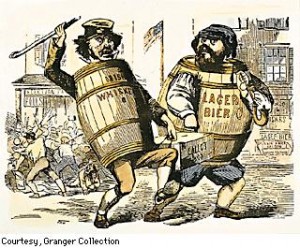 The debate over the health impact of booze, and beer in particular, flows on.
The debate over the health impact of booze, and beer in particular, flows on.
On one hand, as we’ve noted before, there are multiple risks and benefits associated with alcohol. And “a woman might find the risks and benefits shift over time, with the cancer risks of drinking dictating abstinence in a woman’s youth and the coronary benefits supporting that glass or two of wine after age 50.” Also, this: “Middle-aged women who drink alcohol in moderation have a better chance than nondrinkers of staying healthy as they age, especially if they spread out their consumption over most days of the week.” And the CDC’s observation that moderate consumption is up there with diet and exercise as behaviors that cut mortality rates. (Other studies are cited here.)
On the other hand, we all know stories of how addiction has made life hellish for someone (and usually many ones).
Within the debate there are sub-debates, and one that intrigues us is the good or bad that comes from mixing alcohol and exercise.
And by alcohol, we mean beer. People rarely mix exertion and vodka or tequila (excluding dancing, of course). An exception would be Tour de Franzia events, in which boxes of wine are stashed along running or biking routes.
And by exercise, we usually mean running.
The beer-running connection has legs. The fabled Hash House Harriers trace their origins to 1938 in Kuala Lumpur, when British expats began regular Monday runs “to rid themselves of the excesses of the previous weekend.” One of the club’s early objectives was “To acquire a good thirst and to satisfy it in beer.” Today, the international quasi-organization proudly calls itself “a drinking group with a running problem.”
(They can also have other problems. A few years ago, several members used flour to mark a trail through an IKEA parking lot, which somehow spawned a bioterrorism alert, a store evacuation, “a massive response from police” and felony charges.)
So beer (or more precisely, overindulgence in beer) can be a motivation to run. But does it impede or help recovery? The tradition of post-run (and even intra-run) beer seems so entrenched, one suspects that our bodies have been telling us something that science hasn’t gotten around to confirming, which is that beer is what the body needs after exercise. After all, Draft Magazine has a Beer Runner blog. You don’t see a Beer Tennis blog or a Beer Jai Alia blog. (There could be a Beer Skier blog, but I haven’t seen it.)
About a year ago, Runner’s World ran a piece noting the ritual nature of the post-run beer and describing a small study of the impact of post-run beers on the next day’s run. The results showed that women actually performed better after drinking, and men worse. Another study has found that beer is actually superior to water for rehydrating after a workout. (The main researcher supposed “the carbon dioxide in beer helps quench thirst more quickly, and that beer’s carbohydrates replace calories lost during physical exertion.”)
But just because everyone does it, and one study says it’s better than water, the average runner should be cautious. In Alcohol, Athletic Performance and Recovery, a 2010 summary of studies, the authors point out that “the data demonstrates a severe lack of analysis on the possible detrimental action of alcohol in the recovering athlete. However, based on the available experimental evidence…athletes should remain wary of ingesting alcohol following intense exercise, focusing instead on effective dietary strategies proven to enhance recovery.”
On a practical note, Metro Canada has a recap of the beer-and-run culture in Toronto that includes a warning from sports nutritionist, author and runner Nancy Clark that “beer is diuretic and if consumed on an empty dry stomach will hit a runner ‘like a ton of bricks.’ After a run, you should drink water first, or consume carbohydrates and protein, before having a pint, she said.”
If already you feel like you’ve been hit by a ton of bricks—or even a few bricks—following a good long run, adding a beer into the mix is probably not in your best interest.
Photo: “Irish immigrant in whiskey barrel and German immigrant in beer barrel run off with ballot box in US election.” Caricature from 1850, reprinted in Smithsonian Magazine in 1996.









